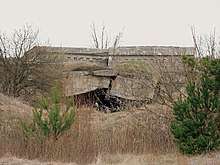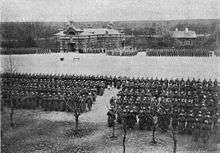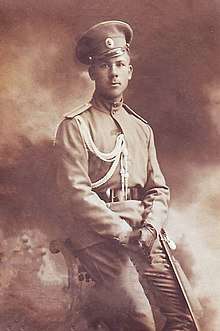Osowiec Fortress
Osowiec Fortress (Polish Twierdza Osowiec) is a 19th-century fortress located in north-eastern Poland, built by the Russian Empire. It saw heavy fighting during World War I when it was defended for several months by its Russian garrison against German attacks.



The fortress was built in the years 1882–1892 as one of the defensive works to protect the western borders of Russia against Germany, and continuously modernised afterwards to cope with advances in heavy siege artillery. In 1889–1893, military engineer Nestor Buinitsky took an important part in the creation of the fortress. It was located on the river Biebrza about 50 km from the border with the German province of East Prussia, in the one place where the marshlands of the river could be crossed, hence controlling a vital chokepoint. The extensive marshlands and bogs that surrounded it made attacks upon it difficult. The strategic Belostok–Lyck–Königsberg rail line also ran through the fortress and crossed the Biebrza river there. The fortress saw heavy fighting during the beginning of World War I in the eastern front from September 1914 until the Russian Army abandoned it in August 1915. In the interwar years the fortress was used by the Polish Army. During the German invasion of Poland in 1939 it was bypassed and did not see much fighting.
Today, some parts of the fortress are accessible to tourists, especially the parts within the boundaries of Biebrza National Park. The visitor information center of the park is located in Osowiec-Twierdza,[1] a small settlement located within the boundaries of the fortress. Other parts of the fortress still belong to the Polish Army and access is restricted.
First World War
First German Assault (September 1914)
In September 1914, Russian field defenses surrounding the fortress were attacked by 40 infantry battalions of the German 8th Army; the attackers enjoyed significant numerical superiority. By 21st of September, the German advance brought the fortress proper within range of German artillery; further reinforced with 60 additional guns of calibers up to 203mm, but these could only be brought into action on 26 September. Two days later, a German frontal assault was repelled by Russian artillery. The day afterwards, two Russian flanking counter-attacks forced German artillery to relocate, taking the fortress outside of German artillery range.
Second Battle (February-March 1915)
On 3 February 1915, the numerically superior Germans launched another assault. The first line of Russian field defenses consisted of shallow trenches and held for five days. On 9 February the Russians withdrew to the second line with deep trenches and established machine gun emplacements, and gave no ground for another two days. The second line remained unbroken.
The retreat from the first line allowed German artillery to start firing on the forts on February 13. The caliber of German heavy siege artillery varied from 100 mm up to 420 mm, firing in salvos of 360 guns every four minutes. Throughout the week-long artillery barrage, 250,000 shots were fired from the heavy guns and about one million rounds were fired from the light artillery pieces.
Russian Central Command expected the fortress to fall; it requested the defenders to hold for at least 48 hours to allow for evacuation of civilians. The fortress would hold until August.
The Russians suffered heavy losses from the artillery barrage, which was strongest from 14 to 16 February and from 25 February to 5 March 1915. Multiple hits inside the fortress and the collapse of many buildings made movement between different parts of the fortress almost impossible. Subsequently, the sector relapsed to positional warfare.
It is sometimes incorrectly claimed that Russian counter-battery fire destroyed two German heavy mortars; these guns were withdrawn for operations elsewhere.[2]
Third Battle (July-August 1915)

The Germans launched a full frontal offensive on the fortress at the beginning of July; the attack included 14 battalions of infantry, one battalion of sappers, 24–30 heavy siege guns, and 30 batteries of artillery equipped with poison gases led by Field Marshal Paul von Hindenburg. Russian defenses were manned by 500 soldiers of the 226th Infantry Regiment Zemlyansky, and 400 militia.
The Germans knew the Russians did not have any gas masks so the chose to use chlorine gas. The Germans waited until 4 a.m. on 6 August for favorable wind conditions, when the attack opened with regular artillery bombardment combined with chlorine gas.[3] The ensuing battle was known as the Attack of the Dead Men. The Russians put on wet rags on their faces to filter some of the gas. Most died but some survived the gas attack. Even while suffering severe chemical burns the Russians were able repel the attack because the Germans panicked and retreated.
The Russians did not hold Osowiec for much longer. The Germans threatened to encircle the fortress with the capture of Kovno and Novogeorgiesk. The Russians demolished much of Osowiec and withdrew on 18 August.[2][4]
Second World War
After the First World War, the Second Polish Republic refurbished parts of Osowiec and used it to house Polish army units, including the Central School of Non-Commissioned Officers of the Border Protection Corps.[5]
The 135th Reserve Infantry Regiment was formed from the school after Germany invaded Poland at the beginning of the Second World War. The Poles abandoned the fortress on 13 September. The Germans captured it and passed it to the Soviet 20th Motor Rifle and Machine Gun Brigade on 25 September. Osowiec was subsequently garrisoned by the Soviet 10th Army. The Germans recaptured Osowiec on 27 June 1941 during Operation Barbarossa; one use of the fortress was as an ammunition dump there. On 14 August 1944, the Soviet 49th and 50th Armies captured three of the forts during the Osovets Offensive of Operation Bagration. Fort II remained in German hands until January 1945, when it was abandoned during the Vistula–Oder Offensive.[5]
Post-War
In 1953, the fortress was regarrisoned by a Polish Air Force ammunition depot,[5] which was absorbed into the 11th Regional Materiel Base in 1998.[6] In 2011, the Osowiec garrison became part of the 2nd Regional Logistics Base.[7]
In 2019, Swedish power metal band Sabaton released a song, part of their "The Great War" album, called "The Attack Of The Dead Men" about the event that took place at the fortress during WW1 [8]
Russian metal band Aria released a song about the event, titled Атака Мертвецов (Attack of the Dead), on their 2014 album Через все времена (Through All Times).
References
- Lonely Planet guidebook Poland
- Kauffman & Kauffman, 2016, pp. 112–113
- Regarding the gas attack of the 6 August 1915, historians' accounts conflict in some details. Chlorine gas was used according to some authors (Kauffman & Kauffman, 2016 ; Buttar, 2017), whereas a mixture of chlorine and bromine was used according to other authors (Cherkasov et al., 2011 ; Khmelkov, 1939). The gas was contained in artillery shells according to one source (Kauffman & Kauffman, 2016), whereas the gas was contained in cylinders according to other sources (Buttar, 2017; Cherkasov et al., 2011; Khmelkov, 1939).
- Kauffman & Kauffman, 2016, p. 225
- Worona, Mirosław. "Historia Twierdzy Osowiec". szuwarygoniadz.pl (in Polish). Archived from the original on 2017-08-13. Retrieved 2017-06-08.
- "11 RBM – 11 Rejonowa Baza Materiałowa Olsztyn". 2009-05-11. Archived from the original on 2009-05-11. Retrieved 2017-06-08.CS1 maint: BOT: original-url status unknown (link)
- "RYS Historyczny". 2rblog.wp.mil.pl (in Polish). Archived from the original on 2017-06-12. Retrieved 2017-06-08.
- "The Attack Of The Dead Men - Lyrics". Sabaton Official Website. Retrieved 2020-02-19.
Bibliography
- Kauffman, J.E.; Kauffman, H.W. (2016). Verdun 1916: The Renaissance of the Fortress. Barnsley, England: Pen and Sword.
- Хмельков С.А. (Khmelkov, S.A.) (1939). Борьба за Осовец (Struggle for Osovets) (in Russian). Moscow: Государственное военное издательство наркомата обороны СССР.
- Perzyk Bogusław (2004). Twierdza Osowiec 1882–1915 (in Polish). Warszawa: Militaria Bogusława Perzyka. ISBN 83-907405-1-6.